Join us for conversations that inspire, recognize, and encourage innovation and best practices in the education profession.
Available on Apple Podcasts, Spotify, Google Podcasts, and more.
Each session of The Learning Classroom generally concentrates on a single learning theory and describes how it might be applied in a classroom. We all know that teaching is much more complicated than that, because learning theories overlap and work together. The Learning Challenges here will help you integrate the ideas presented across different sessions.
We have selected a series of scenes from the video programs that can be looked at through different “lenses” of learning theory. For each of the scenes, we have provided a number of “tools” to guide your learning:
Rubrics for Scenario Sequenced Writing Assignments
Use these as a basis for writing your own rubrics for assessing the writings of your group members.
| 4 | 3 | 2 | 1 | |
| Learning Theory Key Ideas | Comprehensive listing of 5 different ideas from each of the four learning theories presented. |
Listing of 4 different ideas from each of the four learning theories presented. |
Listing of 2-3 key ideas from only three out of four learning theories presented. |
Very few key ideas from only 1 or 2 of four learning theories presented. |
| Teacher’s Application of Key Ideas | Comprehensive listing of 5 teacher applications of key ideas from each of the four learning theories presented. |
Listing of 4 teacher applications of key ideas from each of the four learning theories presented. |
Listing of 2-3 teacher application of key ideas from only three out of four learning theories presented. |
Very few key ideas from only 1 or 2 of four learning theories presented. |
| Discussion of Learning Perspectives | Well-integrated discussion of examples given for all four learning theories.Perspective from which theories evaluated clearly stated. |
Good discussion of examples given for all four learning theories.
Perspective from which theories evaluated clearly stated. |
Moderate discussion of examples given for all four learning theories.Perspective from which theories evaluated clearly stated. |
Weak discussion of examples given for all four learning theories.
Perspective from which theories evaluated not clearly stated. |
| Grammar, Mechanics of Writing | Few, if any, noticed grammatical or mechanical errors | Errors do not interfere with reading | Errors interfere somewhat with reading | Errors interfere greatly with reading |
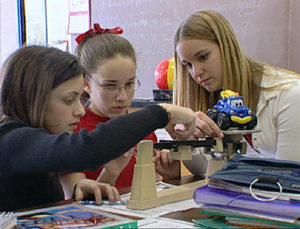
Teacher: George Mixon
School: Birmingham Covington School, Birmingham, Michigan
Grade: eighth grade science
Video: Episode 2, Learning As We Grow. Segment begins approximately 12 minutes into the program.
Primary Learning Objectives
By participating in the learning activities, students should be able to:
Learning Activities
Students are pulled into a scientific experiment by becoming active participants in setting it up, collecting data on distance, time and speed of miniature cars as they travel down a sloped ramp, and calculating momentum. Students learn how to organize and analyze data as they test a hypothesis identifying the independent and dependent variables in the experiment.
Learning Theories to Consider
Narrative
George Mixon reports that students in his eighth grade science class need something concrete before they can move to abstract ideas. He uses their prior knowledge about sledding and snow boarding to help them connect to collecting data on the distance, time, and speed of miniature cars. By engaging students in a generally familiar hands-on-activity they become immediately focused and are more inclined to take what Mixon refers to as “intellectual risks.” When questioned about the type of graph they should construct to collect the data, they select the line graph because it demonstrates continuous data over time — a concept they learned in seventhgrade.
As students test their cars in two different groups, unplanned barriers impact their experiment. The two groups are encouraged to try different methods to control the variables while they collect and organize their data. Assigning groups allows students to build relationships and work collaboratively while Mixon observes if students are flexible with their thought processing while making connections to new learning.
In this scenario, George Mixon demonstrates several learning theories. By understanding his students “mental and physical readiness to receive new information,” Mixon is using the theory of Development and Learning. He builds success for his students by engaging in Cognitive Processing, a learning theory designed to help students process new information by making connections to prior knowledge. In this classroom Multiple Intelligences are tapped as students are encouraged to explore problem solving by using, for example, their linguistic, logical-mathematical, and bodily-kinesthetic intellectual strengths. Finally Mixon demonstrates the theory of Emotions and Learning as he creates a trusting classroom environment by forming relationships with and among students that encourage risk taking.
Sequenced Writing Assignments:
Reflect on the completed table and record your reflections about how the theories intersect or interact. How might your own teaching practices take advantage of what you see happening in this scenario?
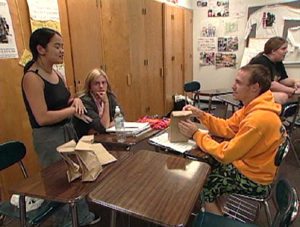
Teacher: Pete Shaheen
School: Birmingham Seaholm High School, Birmingham, Michigan
Grade: 12th Grade Creative Writing
Video: Episode 8, Watch It, Do It, Know It. Segment begins approximately 14 minutes 45 seconds into the program.
Primary Learning Objectives
By participating in the learning activities and following the models demonstrated by the instructor, students should be able to:
Learning Activity
Groups of students discussed the work of their writing class and decided they wanted to strengthen their ability to write engaging descriptions. Based on that, they designed and conducted mini-lessons using the writer’s workshop models that the teacher also follows. The students created five stations corresponding to each of the five senses. Other students in the class moved from station to station, experiencing something using one of their senses and describing it in writing. One member of the planning group supervised each “station of the senses.” At the end of the exercise, students shared their writings with the class and discussed them.
References for the writer’s workshop come from two texts:
Learning Theories to Consider
Narrative
Pete Shaheen demonstrates the advanced outcomes of a cognitive apprenticeship approach that incorporates peer teaching with his 12th grade writing class. Shaheen explains that the process involves finding a way to transfer the domain of authority from the teacher to the students. As peer teaching is strengthened over time, the teacher becomes less involved in teaching and more involved in guiding and advising students to become independent learners. More importantly, he assist students in wanting to be in control of how they learn and what they learn to enhance their knowledge.
This scenario shows three students led by a peer teacher as they explore the use of their senses to enhance their writing skills. The student peer-teacher guides the other students through the experience of touching items in a paper bag. Participants then describe their sensations orally and ultimately in writing.
There are several learning theories presented in this scenario. Pete Shaheen uses Cognitive Apprenticeship to influence learning by organizing knowledge in a scaffolding method designed to transfer teaching to students who ultimately become peer-teachers. As they take on the role of teacher, he helps students to make their thinking visible so they can talk about their ideas with each other to improve their writing skills. The students are learning from each other in a Social Context as they work together in small groups to design their writing projects. They inspire each other to enhance their writing by employing the paper bag exercise and then getting students to think “outside of the bag.”
As he gives students opportunities to structure their own learning, he forces them to use Metacognition. They must think about their own learning strategies and design activities to help each other learn. Finally, Shaheen demonstrates that none of these learning theories could take place unless the classroom is designed to be a safe environment where students can test their ideas based on their own cultural experiences. He recognizes the relationship of Culture and Learning as he structures the learning culture of his class to be complementary to the culture and ethnicity of the students.
Sequenced Writing Assignments:

Teacher: Don Johnson
School: Columbus Middle School in Detroit, Michigan
Grade: Eighth Grade Technology
Video: Episode 11, Lessons For Life. Segment begins approximately 14 minutes 45 seconds into the program.
Primary Learning Objectives
Students who successfully complete the activities should be able to:
Learning Activity
Student groups run “companies” that have a budget and other considerations as they plan and build toothpick bridges. Conditions change during construction and students must adapt and often barter to complete their projects.
Lesson plans adapted from Building Toothpick Bridges by Jeanne Pollard (Dale Seymour, 1985)
Learning Theories to Consider
Narrative
In this scenario Don Johnson sets up his eighth grade students to become engineers in a bridge-building project. Students are assigned to five-member “companies” and are charged with building a bridge with toothpicks. There are multiple tasks involved including applying mathematics, the principles of design, and the principals of physics. The students are given a budget for construction, and they are required to consider factors such as the cost of land as well as the cost of materials. Each company is in a friendly competition with the other companies as they consider carefully how to allocate their resources to complete their bridge.
Halfway through the project, the cost of materials is increased “due to inflation brought on by national events.” Companies are required to look at their resources to determine if they can afford to assist failing companies without endangering the completion of their own bridge. Students become entrepreneurs by taking advantage of opportunities to sell materials to struggling companies at a lower cost than originally announced by their teacher.
Johnson demonstrates Learning and Transfer by providing his students with a knowledge-rich environment to transfer what they know fundamentally about the principals of physics to an actual event, “building a bridge.” Over a period of time, the students provide each other with feedback and self-monitoring as they construct their bridge. Johnson’s class is an elective class in technology that receives in-kind support from a professional engineering society. Creating bridges of another sort to the community is an example of Creating a Classroom That Supports Learning.
When Johnson begins the assignment with helping students to remember the principals of physics and the principles of design, he is using the Structure of the Disciplines learning theory. He states that he wants students to understand that “science is not unconnected.” These principles become the core knowledge students will retrieve as they construct new learning to complete their bridge. Johnson models Motivation as he encourages students to take risks without contemplating failure. He provides them with concrete positive feedback that identifies their strengths while helping them to reassess what is working and what is not working in their construction. An important part of this learning is helping students to feel self-confident in approaching new situations armed only with their ability to know how to learn.
Sequenced Writing Assignments
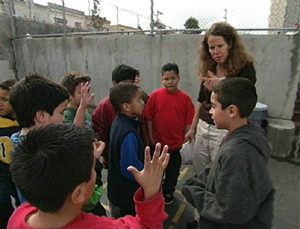
Teacher: Kiristin Bijur
School: San Francisco Community School
Grade: Fifth
Video: Episode 5, Feelings Count. Segment begins approximately 11 minutes 45 seconds into the program.
Primary Learning Objectives
When the students complete their discussion with the teacher on the playground they should be able to:
Learning Activities
Two groups of students who wanted to play different sports in the same playground space had to resolve the issue peacefully. One group participated in a problem-solving and debriefing discussion of the situation with their teacher.
Learning theories to consider
Narrative:
In this scenario Kristin Bijur listens as a group of boys discuss their concern about girls who infringed upon the limited playground space they are using to play soccer. The boys share that they have moved their space already — showing their empathy for the girls’ needs — but now realize that the problem has not been solved. By listening to the boys, Kristin Bijur provides them with a structure to manage their feelings by asking them to “talk out loud” about how they feel and what some possible solutions might be. Along the way, she commends them for trying to solve the space issue in a “peaceful and harmonious” way.
Her intent is to provide a safe environment where students can express their likes and dislikes without fearing verbal and/or physical confrontation. An emotionally safe environment motivates students to trust that the teacher will listen without bias and will help them work through their conflicts. The trust that is established between the teacher and students ultimately begins to transfer among students.
The theory of Emotions and Learning is demonstrated when Kristin Bijur helps students express how they feel while solving the playground space issue in an acceptable way. She understands that students’ emotions have an impact on their learning and uses the turf issue as a teachable moment to assist students in resolving conflict before it moves from the playground into the classroom. The theory of Development and Learning suggests that students at this age are not always developmentally ready to handle their own problems. Bijur supplies students with a structure for solving their problem by asking questions to get them to move beyond blame to resolution. As she acknowledges the students’ thoughts and actions she is also making the conflict resolution process more visible. This application of Cognitive Apprenticeship theory helps remove the emotional charge of the situation. It further motivates students to be in charge of their emotions as they solve problems instead of withdrawing or striking out in unproductive ways. This also helps them to feel good about themselves. Kristin Bijur demonstrates how to create Schools That Support Learning by taking advantage of a teachable moment whenever or wherever it occurs. Her instruction resolves a need that students had that could have been detrimental to classroom subject matter learning.
Sequenced Writing Assignments:
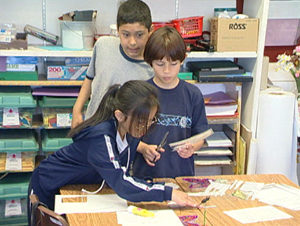
Teacher: Yvonne Scott
School: San Francisco Community School
Grade: Fourth and Fifth
Video: Episode 7, Learning From Others. Segment begins approximately 3 minutes 15 seconds into the program.
At the conclusion of their project, the students should be able to:
Students form teams to create a butterfly garden by discussing what they know and what they need to know. As the project advances, students bring their own special abilities into play as they discover how to learn on their own and how to teach each other the necessary skills to complete the project.
When the project is completed, the students communicate what they have done and learned through presentations to other students and their parents.
Yvonne Scott challenges her fourth/fifth grade students to create a butterfly garden after the school receives special funding from a grant. The garden will consist of a mural describing different species of butterflies on plaques that will include information such as wing span, coloration and life cycle. Although the fourth and fifth graders create the garden, it will be a place of learning for the entire school.
The teacher begins the lesson by asking questions to determine what students know and what skills and knowledge they will need to make a butterfly garden. As the students brainstorm they realize they need lots of information about soil, plants, and the type of garden that will attract butterflies. They also learn they will need math and writing skills to design and chronicle the garden. Yvonne Scott suggests that the students form two teams – a butterfly research team and a garden layout team. As the project develops, the teams present their research and drawings of the garden to the entire class. They record the feedback from the presentation and based on the feedback, present a final plan for the garden.
In this scenario, Yvonne Scott applies Learning in a Social Context by placing students in a communicative and interactive learning culture. Students work collaboratively in teams, and as their individual talents emerge, they become teachers as well as learners. She applies the theory of Cognitive Processing as she challenges the students to create the garden, while helping them retrieve what they already know and what they need to know to become problem solvers. As the project develops over a ten-week period, Yvonne Scott sees the culture of the classroom change dramatically. The theory of Culture and Learning shares that students make sense out of their environment by their own personal experiences. As the students become personally involved and responsible for segments of the work needed to build the garden, they are experiencing a shift in culture. Students learn to rely on each other for “pieces of the puzzle” instead of working independently. They also learn to appreciate and value each other for who they are and the talent each student brings to the project. Diversity is viewed as a big asset in this multiethnic and multitalented class.
Throughout the project the students are asked “what do you wonder; what do you think?” They also discuss their specific problem solving strategies. These are examples of Metacognition, a learning theory that describes how students learn to think about their own thinking.
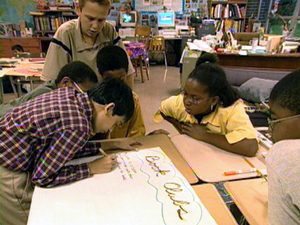
Teacher: Kathleen Hayes-Parvin
School: Birney Middle School Southfield, Michigan
Grade: Sixth Grade Language Arts/Social Studies
Video: Episode 9, Thinking About Thinking. Segment begins approximately 18 minutes into the program.
Primary Learning Objectives
By participating in the learning activities, students should be able to:
Activities
Students created writer’s notebooks with collections of thoughts, clippings and pictures about a subject they were interested in. The students were assigned to groups and did outside reading before sharing their work and discussing their interests. They wrote essays about their topics, documented their process in journals and presented their work to a group of student teachers.
Learning Theories to Consider
Narrative:
Kathleen Hayes-Parvin assigns sixth grade students to work on multiple tasks in collaborative groups to reflect, write, receive, and give feedback to each other in a teaching and learning environment. Students transfer prior knowledge to new learning by making connections through a format Hayes-Parvin describes as reading and writing from “text to text, text to self, and text to the world.” As an example, she provides connections to new learning by assigning students the task of reflecting on the “good” teachers they have experienced in the past and to discuss in their groups what makes the teachers so good. An exciting conclusion for this assignment is that the students share their thoughts and writings on “good” teachers with a second audience of preservice teachers from the University of Michigan. In another assignment she invites students to read a poem written in a particular style before asking them to write their own poem in similar style. In a culminating assignment students write in journals about personal experiences and discuss their writing with each other for feedback.
Although presenting to university teachers in an interactive video- conference is very exciting and motivational, Kathleen Hayes-Parvin demonstrates that the theory of Motivation requires much more. She creates interest by assigning her students the task of writing about their personal experiences. When students share their thoughts and writing with each other in an affirming environment, their self-confidence is enhanced and they feel a sense of accomplishment, and are therefore more motivated to learn.
The video conference also combines many familiar student activities in new ways. As students prepare their presentations they are experiencing Learning and Transfer – applying what they have learned in new situations.
In the classroom and in assigned groups Kathleen Hayes-Parvin creates opportunities for students to excel in multiple ways. Her understanding ofMultiple Intelligences is modeled by the creative assignments she gives her students. Each assignment allows students to demonstrate their strengths. For example some students excel in linguistic Intelligence, communicating their ideas wonderfully well, while others excel in interpersonal Intelligence, thriving in small group experiences where they notice and react to the moods of their friends.
Hayes-Parvin has organized her students’ writing tasks so they model the ways the professional writers work, and are evaluated by the kind of criteria that writers would use. By following the Structure of the Discipline of writing, Hayes-Parvin is focusing on the most important skills and knowledge her students should learn and apply.
Sequenced Writing Assignments: